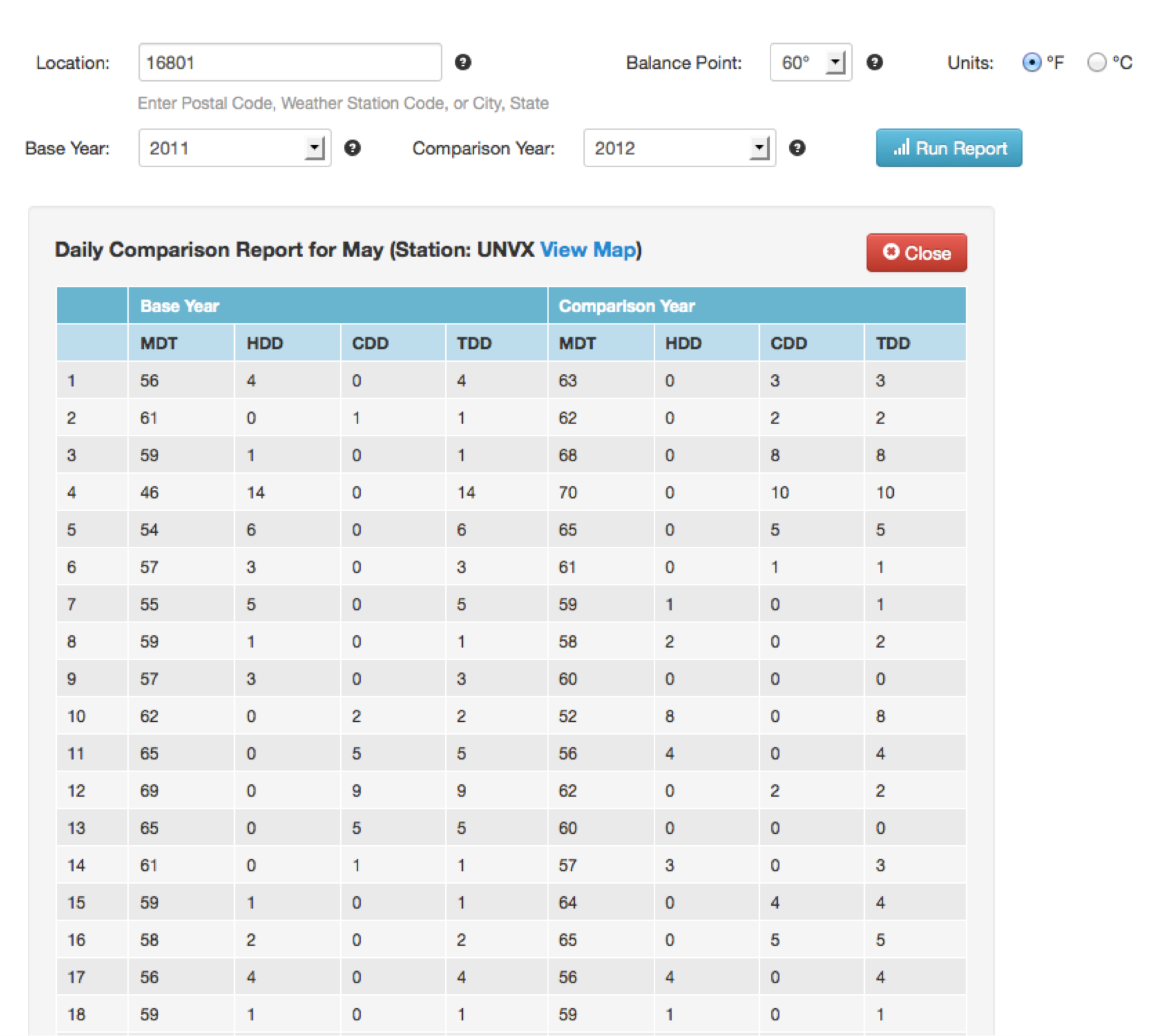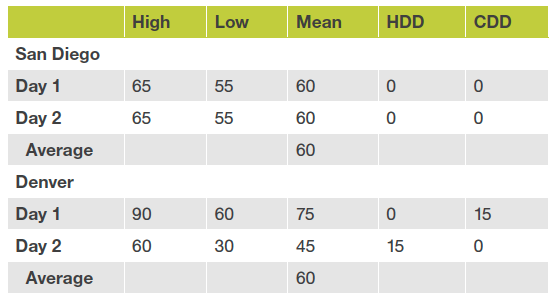Degree days represent the only weather metric that is consistently used in the context of building energy use. Heating degree days represent a need for heating to maintain a comfortable temperature in a building.
Cooling degree days represent a need for cooling to maintain a comfortable temperature in a building. But how are degree days and balance points calculated?
Determining a Balance Point Temperature
The first step is to determine a consistent balance point temperature. This is the point at which a building requires neither heating nor cooling. The balance point for a specific building can vary greatly from a norm/average, depending on a number of factors including construction materials, insulation, date of construction, and more.
Typically values from 55 to 65° F are chosen. EnergyCAP utility bill tracking software uses a linear regression analysis to determine the weather sensitivity of a given gas or electric meter using utility bill information and degree day data. By discarding outlier data points, a ‘best-fit’ line can pinpoint the ideal balance point on a meter-by-meter basis.
After the balance point temperature has been selected, daily degree day totals are calculated by obtaining the mean daily temperature for the building location and comparing that value to the building balance point.
EXAMPLE: Let’s suppose that you’re using a balance point of 60° F for a building, and the mean daily temperature on January 1, 2014 for that location (as determined by a weather data resource such as www.weatherdatadepot.com) is 30 degrees.
To determine the number of heating degree days for that date, compare the mean daily temperature value with the balance point temperature. This comparison reveals that there were 30 heating degree days on January 1, 2014 (60- 30=30).
Smart Degree Day Values
A key to grasping the degree day concept is to realize the importance of tracking daily heating and cooling values separately. If you attempt to simply calculate the average temperature on a weekly, monthly, or annual basis, contrasting heating and cooling data points would cancel each other out, especially in the “swing” seasons of spring and fall.
A linear regression can be performed from known weather and meter energy data to determine the optimum balance point on a building-by-building basis (assuming building-level metering). However, not all analysis is based on the optimum balance point. For instance, if you access a website database such as the National Weather Service, you will often spot a 65° F balance point. The 65° F balance point was established as a reporting standard in the 1930s when the degree day concept was first developed. It was based on daily dry bulb temperature and gas consumption data available for natural gas-heated residences during that period.
Commercial buildings and many institutional buildings today have a much lower balance point. There are a number of reasons for this. The envelope of these buildings is insulated better. There are many more internal heat gains due to equipment and lighting and plug load than would have been present in residences in 1930. So a 65-degree balance point is not really a defensible standard.
Our recommended weather data service, WeatherDataDepot.com, enables the user to set any desire balance point. The default setting is 60.
Here are two exercises to clarify the degree day concept. They are based on the chart data below:

QUESTION:
Assume a balance point of 60° F. Assume a mean daily temperature (MDT) on May 1 of 56° F in the base year (2011). What is the degree day value for May 1?
ANSWER:
The difference between the balance point temperature and the mean daily temperature is 4. Because the MDT is cooler than the balance point, heating would be required, so the value represents heating degree days.
QUESTION:
Assume a balance point of 60° F. Assume an MDT on May 12 of 69° F in the base year (2011). What is the degree day value for May 12?
ANSWER:
The difference between the balance point temperature and the mean daily temperature is 9. Because the MDT is warmer than the balance point, cooling would be required, so the value represents cooling degree days.
As the chart indicates, a degree day value is determined for each day of the month. Each day it is possible to have heating degree days or cooling degree days, or none (MDT = building balance point). But you will never see both heating and cooling degree day values for the same day.
As long as the heating degree days and the cooling degree days are calculated independently, they represent an excellent measure of weather severity. The problem some people encounter is when they attempt to aggregate the two by combining and/or averaging the values.
A Tale of Two Cities
To see why this doesn’t work, consider two cities: San Diego, CA, and Denver, CO. And consider two days:

In San Diego, the mean daily temperature on both days was 60° F, which is fairly typical for San Diego.
By contrast, Denver’s temperatures were quite different. The first day was very hot, with a high of 90° and a low of 60°, producing an MDT of 75° F for 15 cooling degree days. On day two, a cold front from the western mountains blew through, producing a high temperature of 60° F and a low temperature of 30° F, producing an MDT of 45° F for 15 heating degree days.
If we try to aggregate the two-day data for both cities by considering only the MDT rather than the degree day values, we “discover” that their weather was identical. The two-day MDT average is 60° F. The faulty aggregation process has smoothed out the disparate weather data and rendered it meaningless!
In actuality, the energy required to maintain building temperatures in Denver on those two days was much greater than in San Diego. Only the degree day concept enables us to accurately assess the difference in weather severity.
The same principal holds true when considering aggregate annual temperature data. The average annual MDT for San Diego is 65° F. So is Dallas, TX. But in Dallas, people spend much more money on air conditioning in the summer and heating in the winter.
By correctly determining your building’s balance point and degree days, you can begin analyzing weather’s impact on your energy usage.
 Best-in-class portfolio-level energy and utility bill data management and reporting.
Best-in-class portfolio-level energy and utility bill data management and reporting.
 Real-time energy and sustainability analytics for high-performance, net-zero buildings.
Real-time energy and sustainability analytics for high-performance, net-zero buildings.
 A holistic view of financial-grade scope 1, 2, and 3 carbon emissions data across your entire business.
A holistic view of financial-grade scope 1, 2, and 3 carbon emissions data across your entire business.
 Energy and sustainability benchmarking compliance software designed for utilities.
Energy and sustainability benchmarking compliance software designed for utilities.




